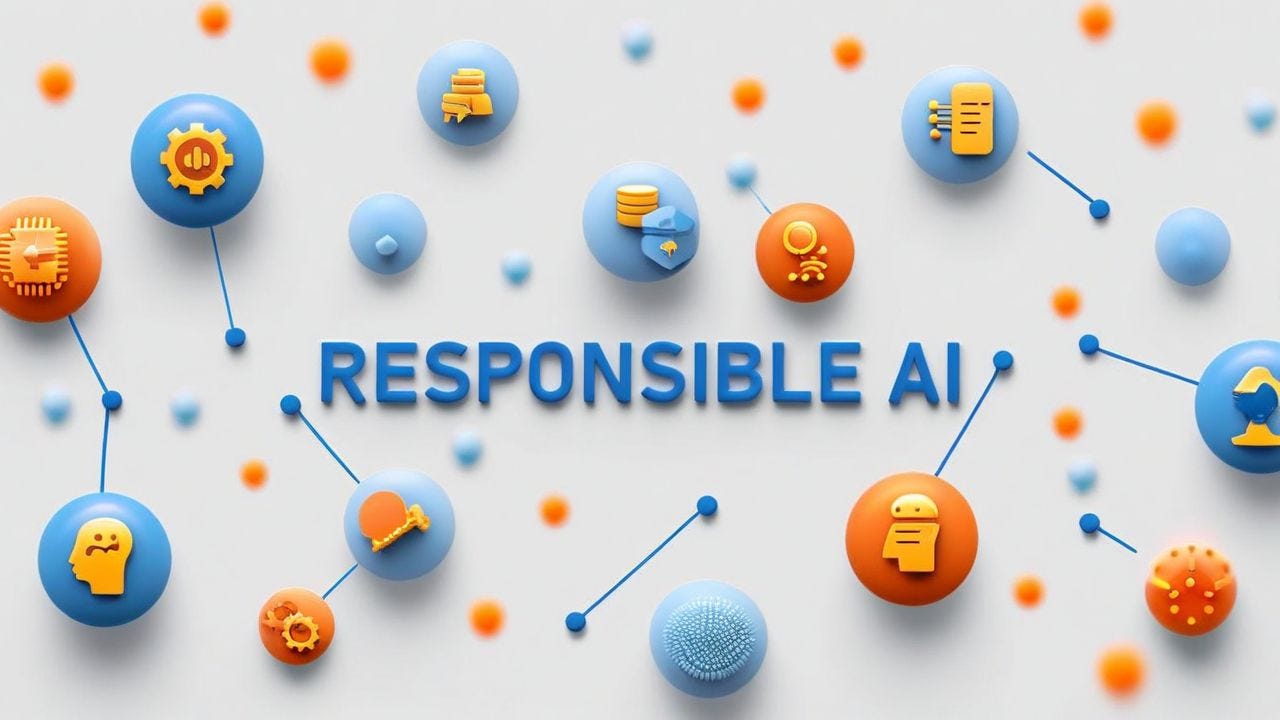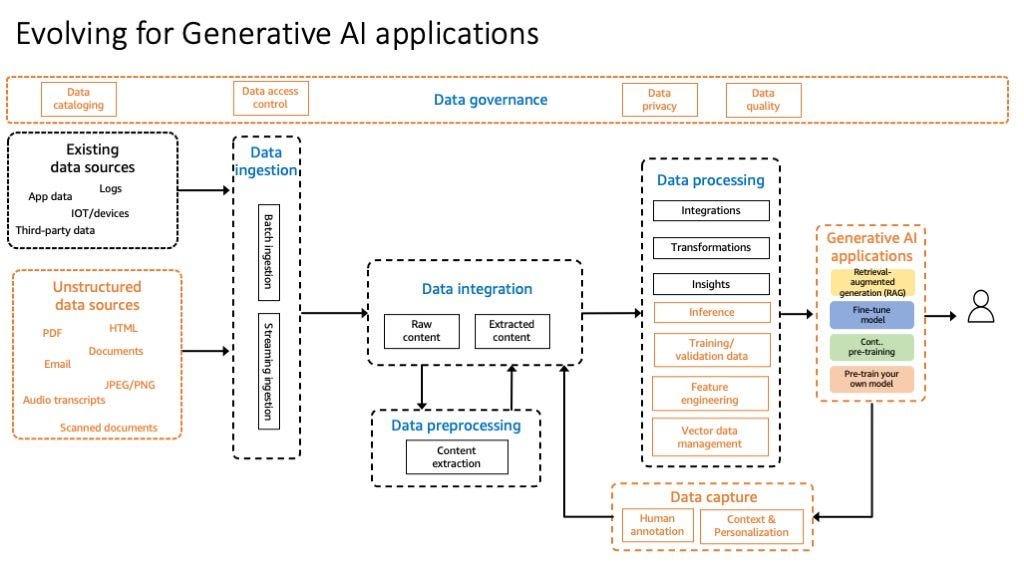
Generative AI which is also called GenAI is transforming industries like healthcare, Finance and retails. The use-cases for GenAI could varies from stand chatbot providing customer support to all the way of generating images and summarizing the complex text. However, this technology bring with it a important questions: How can orgnizations adopt GenAI responsibly while safeguarding their data assets.
This isn't going to be Technical challenge any more but strategic one. GenAI application thrives on data which are often unstructured, Sensitive and siloed. Without proper governance organizations are the risk of penalties, loosing trust on the data and breaches. In this article explores the challenges of data governance in the era of generative AI and offers practical solutions to help businesses innovate responsibly.
Why Data Governance Matters in Generative AI?
Imagine you are driving on the busy street with intersection where traffic is flow smoothly because of the timed signals. Similarly you can think of data governance. It provides the rules and structure to keep everything running in order. In the 1990s and 2000s, frameworks like DAMA-DMBOK and COBIT worked perfectly because most data came from predictable sources like relational databases. But as businesses started collecting data from newer sources like IoT devices, machine sensors, and clickstreams which are of semi-structured in nature made these traditional frameworks to thier limits. Then came Generative AI, which relies heavily on unstructured data like PDFs, images, audio and etc. Managing this type of data is far more complex, like trying to cross an intersection with no traffic lights.
For example, a chatbot trained on unstructured data from different silos might seem innovative, but without good governance, it could use outdated or sensitive information, leading to trust issues, compliance violations, or financial penalties. Poor data quality is another big problem - if LLMs are connected to inaccurate data, they might generate false or misleading results. Even centralizing LLMs to access all organizational data can backfire, as it might violate data residency laws by transferring sensitive information across geographies. The rapid shift from structured to unstructured data has outpaced old governance systems, leaving businesses struggling to keep up. To make the most of Generative AI and protect their data, companies need to rethink their governance strategies and adopt modern approaches. This isn't just about solving problems; it's about staying ahead in a data-driven world.

What are Unique Data Challenges for Generative AI?
Lets explore some of the unique data challenges in detailed.
One of the main concerns is privacy and security risks, especially when GenAI systems are connected to raw data containing sensitive information such as customer records or proprietary business details. Without robust protections like Data masking, encryption, or anonymization, this data is exposed to breaches, which can lead to severe consequences. Adding to the complexity, frameworks like GDPR and CCPA impose strict data protection requirements, including safeguarding personally identifiable information (PII). However, legacy tools used for anonymizing data often struggle to scale with the enormous data volumes generated today.
Next, lets look at ethical and compliance issues. GenAI application can unintentionally introduce biases or produce misleading outputs. Examples include, Sending AI-generated email on behalf of the company which may contain offensive or harmful guidance to employees. A guardrails to evalaute the prompt output from GenAI application is needed for resolving trust issues.
Managing unstructured data, which forms the backbone of most Generative AI applications. Unstructured data, such as PDFs, images, and audio transcripts, accounts for up to 80--90% of the data that Generative AI uses. The difficulty of applying fine-grained access controls to such data is immensely challenging because of the schema-less in nature. The Schema-less data becomes hard to write the rule bases policy to enforce fine-graned access control like column, row, cell level access.
Another key issue is quality control and data integrity. For GenAI systems to produce reliable outputs, they require high quality input data. Messy or synthetic data increases the risk of AI hallucinations meaning outputs that are inaccurate or completely fabricated. As data lakes increasingly become the single source of truth for businesses, ensuring proper data classification and writing effective data quality rules across vast, unstructured datasets becomes an uphill battle. Failure to address these issues can undermine the credibility of AI-driven insights.
Finally, we often overlook option of vector embeddings. Embedding are crucial for enabling advanced AI capabilities like retrieval-augmented generation. But embedding are susceptible for vulnerabilities. If unauthorized actors gain access to vector embeddings, they can reverse-engineer sensitive information from them. This makes embedding encryption and strict access control policies essential to protect critical data and prevent misuse.
Addressing these issues isn't just about mitigating risks - it's about unlocking the full potential of AI in a way that is secure, ethical, and effective.
How to Address Key Data Challenges in Generative AI
Generative AI thrives on data, but as highlighted earlier, the unique challenges of handling unstructured and sensitive data demand a modern approach to governance. Addressing these challenges is not just about mitigating risks but also about enabling GenAI systems to deliver accurate and ethical outputs. Here's how organizations can navigate these complexities effectively:
1. Consolidate all of your Data
Generative AI models thrive on diverse and high-quality data. However, managing this data effectively requires a robust and unified architecture that ensures data governance without stifling innovation. A data lakehouse architecture offers the best of both worlds - combining the flexibility of data lakes with the reliability and performance of data warehouses. If you are hosting your GenAI platform on AWS then services like Amazon S3 and Amazon Redshift provide the lakehouse. These platforms reduce redundancy, enable federated queries, and support secure data sharing, fostering a cohesive governance environment. Modern Lakehouse system also enable Data Sharing so that data doesn't leave the Region/Geo where its hosted but shared and audited from environment to another.
2. Build a Solid Foundation with Data Cataloging
Organizing data is the first step toward effective governance. Data cataloging helps streamline access to unstructured data, enabling AI systems to quickly find relevant and accurate information. Traditional cataloging tools like Informatica and Collibra, along with cloud-native solutions such as AWS Glue, play a crucial role in indexing data. However, for unstructured formats like PDFs and images, AI-powered tools like Amazon Comprehend and Rekognition extract meaningful metadata, making this data searchable and usable. This ensures a unified governance framework for both structured and unstructured data.
3. Strengthen Data Access Controls
Once data is cataloged, implementing fine-grained access controls is essential to protect sensitive information. Tools like AWS Lake Formation, S3 bucket policies, and role-based access control (RBAC) for platforms like Amazon Redshift or Snowflake ensure data security. For advanced GenAI workflows using vector embeddings, encryption techniques like AWS KMS safeguard data from unauthorized access, maintaining the integrity of critical assets.
4. Prioritize Data Privacy
Privacy remains at the core of governance for generative AI. Techniques like data masking, field-level encryption, and hashing protect sensitive information before it enters AI pipelines. Automated tools such as AWS Macie and AWS Glue identify and classify sensitive data, enabling compliance with regulations like GDPR and CCPA. Localization strategies that align with data residency laws further enhance trust and compliance.
5. Maintain High Data Quality
Reliable AI outputs depend on high-quality input data. Assigning quality scores as metadata that live together with data as column will help GenAI system to chose most accurate date to rely on. This can be done using AWS service like Glue Data Quality to build quality checks for your datasets ensure that GenAI systems process only trusted data. This reduces risks of AI hallucinations and improves the overall accuracy of AI-driven insights.
6. Enhance Monitoring and Governance Practices
As GenAI application start to access the data, Its good to keep track of data stores and other application it has interacted or accessed.. So, Continuous monitoring using tools like AWS Audit Manager ensures adherence to governance policies. Real-time audits identify gaps, enabling proactive remediation. Additionally, unified data platforms like AWS Lake Formation allow seamless integration AWS CloudTrail which provides who the users from GenAI prompt accessed the a field/Cell in the data stores/ Lakehouse.
7. Foster Cross-Functional Collaboration
Addressing generative AI challenges requires input from data scientists, compliance teams, IT specialists, and business leaders. Engaging regulators and industry experts ensures governance strategies remain updated with evolving regulations, supporting innovation while mitigating risks. Consensus from these team help to build the strong and stable Data platform for GenAI applications.
8. Policy and Localize of Data
By localizing AI frameworks and segregating data geographically, businesses can avoid unnecessary data movement across regions. Cloud providers like AWS, Azure, and GCP offer region-specific services that comply with local regulatory requirements, ensuring seamless adherence to data residency laws.
Conclusion
Generative AI is transforming how businesses use data, but its success depends on strong data governance. To support this transformation, organizations need governance frameworks that address unique challenges like privacy, unstructured data management, and compliance. By adopting modern tools and strategies, such as data cataloging, access control, and continuous monitoring, companies can ensure their AI systems are secure, ethical, and effective.
The solutions highlighted, like using AWS services to build scalable and secure data platforms, demonstrate how businesses can streamline operations while maintaining data quality and compliance. These frameworks not only simplify data management but also prepare organizations for the future of AI-driven innovation.
In practical terms, this means creating robust platforms that support advanced applications, such as personalized customer experiences, while safeguarding sensitive data. As generative AI reshapes industries, those who implement effective governance will be well-positioned to unlock its full potential responsibly and sustainably. By combining advanced tools, clear policies, and collaboration, businesses can balance innovation with accountability, ensuring success in an AI-powered world.
References
- California Consumer Privacy Act (CCPA). (2020). Retrieved from https://oag.ca.gov/privacy/ccpa
- European Union. (2018). General Data Protection Regulation (GDPR). Retrieved from https://gdpr.eu/
- Gartner. (2023). Data Governance in the Era of AI: Best Practices and Emerging Trends. Gartner Research.
- IBM. (2022). AI Governance: Managing Data and Models. IBM White Paper.
- Khatri, V., & Brown, C. V. (2010). Designing data governance. Communications of the ACM, 53(1), 148-152.
- Otto, B. (2011). A morphology of the organization of data governance. Information Systems and e-Business Management, 9(4), 337-363.
- AWS(2022). How to Create a Data Governance Strategy for Your Small or Medium Business
- Amazon Web Services. (2023). Data governance in the age of generative AI. AWS Big Data Blog. https://aws.amazon.com/blogs/big-data/data-governance-in-the-age-of-generative-ai/
- Eckerson Group. (2023). Data governance in the era of generative AI. Eckerson Group. https://www.eckerson.com/articles/data-governance-in-the-era-of-generative-ai
About the Author

Nishchai J.M. is a seasoned Senior Specialist Solutions Architect with over 15 years of experience in consultancy and advisory roles, specializing in data analytics, AI, and cloud computing. Known for his expertise in modernizing data warehouses, data lakes, and business intelligence, Nishchai collaborates with organizations to unlock the full potential of their data. He actively contributes thought leadership through blogs, Public speaking in platform like Re:invent. Passionate about innovation, Nishchai advises a start-up company on product development and provides strategic guidance to businesses, including those in the travel and hospitality sector, to solve complex data challenges.


